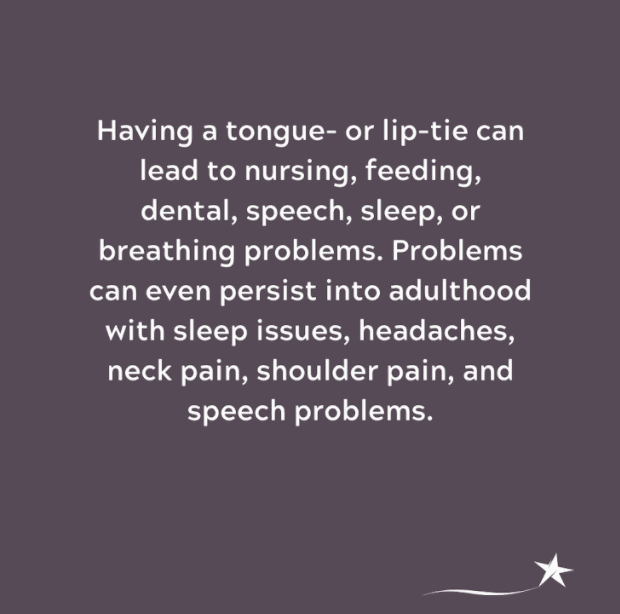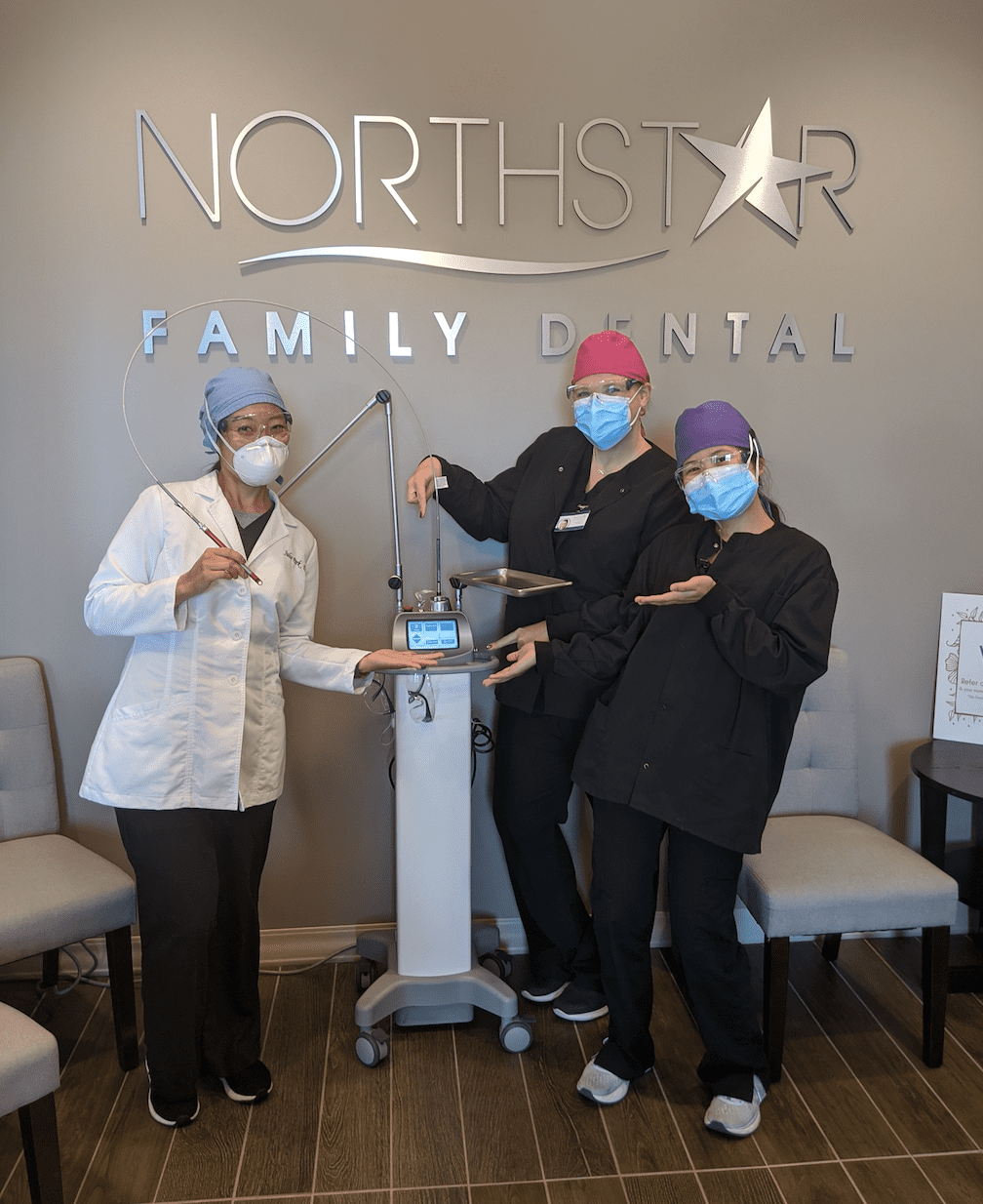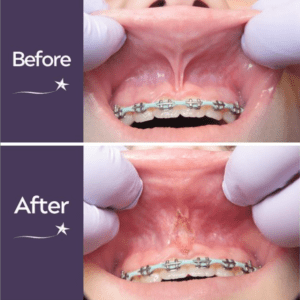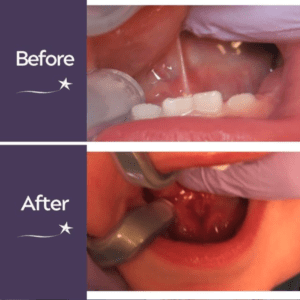Northstar Family Dental Lip & Tongue Tie Center

The phrase “tongue tied” is commonly used as a slang reference to someone stumbling over their words. However, tongue and lip ties (medically known as Ankyloglossia) can lead to serious complications in infants, adolescents and even into adulthood if left untreated.
WHAT IS A TONGUE TIE?
Tongue ties are caused when the lingual frenulum (the membrane which connects the tongue to the floor of the mouth) is thick, short, or otherwise malformed, restricting the tongue from moving correctly.
WHAT IS A LIP TIE?
Similarly, a lip tie is when the frenulum band of tissue that connects the upper lip to the gum is thick, short or inelastic, restricting the lip from moving.
WHAT ARE THE ISSUES ASSOCIATED WITH TONGUE/LIP TIE?
– FOR INFANTS, tongue tie or lip tie may mean unsuccessful breastfeeding or bottle feeding.
For infants born with tongue or lip tie, the restriction does not allow the lip to rest passively over the nipple for proper suctioning.
Symptoms you may notice can include:
- Difficulty latching or staying on latch
- Excessive gas or burps
- Gagging and choking
- Milk dribbles
- Reflux/colic
- Excessive spitting up
- An arched back due to discomfort
- Falling asleep at the breast
- Long feeding times or continual feeding
- Lip calluses or blisters
- Swallowing air
- Chomping on the nipple
- Comes off latch
- Can only feed during letdown
- Tucking of the upper lip
- Fussing/fighting at the breast
- Acts tense while nursing
- Sensitive gag reflex
- “Lazy Eater”
- Difficulty holding a pacifier
- Failure to gain weight
– NURSING MOTHERS may find it difficult or painful to breastfeed.
Tongue and lip ties don’t only affect the infant. A baby’s tethered oral tissue can also cause physical and emotional issues for a breastfeeding mother, which could include:
- Painful Latch
- Shallow Latch
- Distorted, sore, damaged, and/or bleeding nipples
- Plugged ducts
- Mastitis
- Feelings of failure or disappointment
- Loss of milk supply (especially after 3 months)
- Nipple throbbing (vasospasms)
– As BABIES GROW they may experience difficulty eating solid foods.
Tongue and lip tie symptoms in babies may include:
- Eating slowly (often the last one to finish a meal)
- Very picky about food, especially textures
- Choking when transitioning to solid foods
- Gagging or spitting food out
- Refusing to wean
- Difficulty swallowing
- Easily distracted during mealtimes
- Grazing on food throughout the day
- Failure to gain weight
If left untreated, the problematic side effects of tongue and lip tie continue into adolescence and adulthood.
– CHILDREN may have difficulties with Speech.
The tongue has a remarkable ability to compensate, so a child may never show signs of difficulty at all. However, not all children are able to adapt and the signs and symptoms of a tongue and lip tie during childhood may include:
- Trouble articulating sounds (- l, r, t, d, n, th, sh, and z)
- V-shaped notch at the tip of the tongue
- Inability to stick out the tongue past the upper gums
- Inability to touch the roof of the mouth
- Difficulty moving the tongue from side to side
While all of side effects and potential long-term complications as a result of tongue and lip tie in infants may feel scary and overwhelming.



Northstar Family Dental is proud to offer a simple, effective and painless solution.
Dr. Julie Park, our board certified oral surgeon is extensively trained and certified to perform laser frenectomies (also known as laser frenulectomy, laser frenotomy, or laser lip- or tongue-tie release) using a LightScalpel CO2 laser.
A Frenotomy, or laser lipor tonguetie release, is the laser removal of a frenulum, the small fold of tissue that prevents part of the body from moving too far.
The incredible CO2 Laser technology allows Dr. Park to safely and efficiently perform the minimally invasive procedure with predictable and instant results. There is no blood, no sedation needed and little-to-no pain.
The procedure is a relatively fast, often taking less than 10 seconds of laser time to release a tongue or lip tie.
The procedure may be performed as early as a couple of days after birth and can be performed into adulthood.

When is the best time?
Typically, once a problem with a tongue-tie or lip-tie has been discovered, the sooner it is addressed the better the procedure will work and the fewer issues the child will have.
To ensure the best experience and rate of success for nursing mothers, we offer a partnership with an International Board Certified Lactation Consultant for pre-and-post procedure support.



How to Schedule
Please call our office at 614-891-4242 to schedule your consultation. Then fill out the evaluation form and return to our office one week prior to your consultation to allow Dr. Park to prepare for your appointment.
POST FRENECTOMY AFTER CARE INSTRUCTIONS
Muscles around mouth, jaw, neck and throughout body can be tense from a tongue tie; improving tongue motion along with whole body posture and movement is important to the success of the release
Goal: Full tongue motion in all directions (up, out, side to side) to allow released tissue to heal with more flexibility and strength for better feeding function
When?
4x/day for 4 weeks, may be helpful to do after a feeding when infant is relaxed and tongue is warmed up with movement; follow with a feeding to further apply new movement
How?
Massage and tongue lifts to strengthen head, face and mouth muscles, 4 repetitions each; tummy time
1. Facial massage: slowly stroke around eyes, across cheeks, downward from ears to chin, and then around mouth
What you should see: some jaw opening with tongue movement upward and outward
2. Oral massage: slowly trace lower gum and upper gum side to side
What you should see: tongue moving side to side
3. Tongue lifts: gently press downward under one side of tongue and hold a few seconds, gently press downward on other side and hold a few seconds, follow with gently pressing downward on both sides simultaneously and then lifting tongue
What you should see: tongue lifting upward with a white or yellowish diamond shaped wound underneath that gets thinner as it heals
4. Lip Lifts: place fingers in fold of front upper lip and gently pull upward to cover nostrils
5. Tummy Time: see www.tummytimemethod.com
- What you should see: hands coming to mouth, jaw opening, tongue coming out as with latching, head movement equally side to side
Recommendations/Insights:
- Follow-up with an International Board Certified Lactation Consultant (IBCLC) within 2-3 days
- Sometimes there is immediate improvement in feeding and sometimes it is incremental
- Skin to skin and warm baths can be comforting
- Additional work with a bodyworker (PT, OT, DO, Chiropractor, Craniosacral Therapist, Massage Therapist skilled in working with infants)to facilitate more balanced movement and function
Pain Control:
- Skin to skin, frequent breastfeeding as able, warm baths
- Children’s Tylenol starting upon return home and every 4-6 hours for 2-3 days
| Weight (lb) | 6 | 7 | 8 | 9 | 10 | 11 | 12-14 | 15-17 |
| Dosage | 1.25ml | 1.5ml | 1.75ml | 2ml | 2.25ml | 2.5ml | 2.5ml | 3ml |
